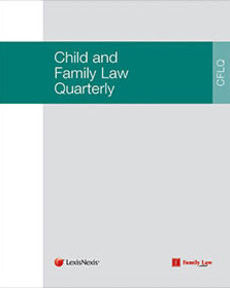Our articles are written by experts in their field and include barristers, solicitors, judges, mediators, academics and professionals from a range of related disciplines. Family Law provides a platform for debate for all the important topics, from divorce
and care proceedings to transparency and access to justice. If you would like to contribute please email
emma.reitano@lexisnexis.co.uk.
The practical realisation of children and young people’s participation rights: special educational needs in England
© Copyright LexisNexis 2025. All rights reserved.
Neville Harris and Gail Davidge, University of Manchester
Keywords: Children – Rights – Participation – Special needs – Disabilities – Autonomy
 The full version of this article will appear in Child and Family Law Quarterly, Vol 31, No 1.
Find out more or request a free 1-week trial of Child and Family Law Quarterly. Please quote: 100482.
The full version of this article will appear in Child and Family Law Quarterly, Vol 31, No 1.
Find out more or request a free 1-week trial of Child and Family Law Quarterly. Please quote: 100482.
Children and young people have until relatively recently had few independent rights under the law governing special educational needs (SEN) in England. Now, however, under part 3 of the Children and Families Act 2014, not only have the governance and coverage of SEN provision changed, but there is also a new focus on children and young people’s rights, aimed not only at enabling their wishes, feelings and choices to influence decisions about their own education but also at ensuring that local provision is properly informed by child/young person perspectives. Drawing on our research for an ESRC funded Anglo-Scottish research project: Autonomy, Rights and Children with Special Educational Needs: A New Paradigm?, we explore the factors driving the extension of the rights of children and young people with SEN and disabilities in England and seek to highlight challenges and difficulties that have arisen in delivering them in practice, including issues of conflict between their wishes and their parents’, and questions of mental capacity.
This article has been accepted for publication in Child and Family Law Quarterly in Issue 1, Vol 31, Year 2019. The final published version of this article will be published and made publicly available here 24 months after its publication date, under a CC-BY-NC licence.


 The full version of this article will appear in Child and Family Law Quarterly, Vol 31, No 1.
The full version of this article will appear in Child and Family Law Quarterly, Vol 31, No 1. 


